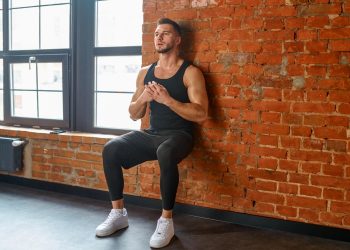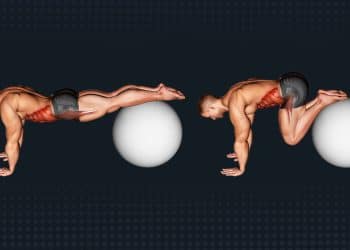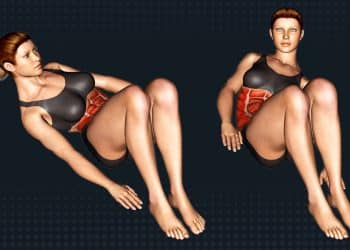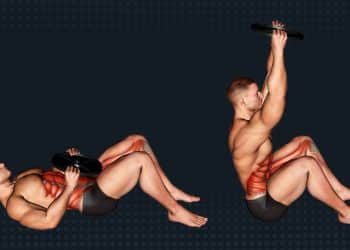The rolling bridge is more of a therapeutic release technique combined with resistance exercise and stretching all in one. It’s a great way to release tension in the stress areas such as your neck and spine whilst giving yourself a back massage. You’ll also find that it’s a great mental relaxation technique which is why many yoga practitioners incorporate it and similar movements.
Choose a soft surface and follow along as we explain the benefits of rolling bridges along with some awesome variations, and an ideal sets and reps range.
How To Do The Rolling Bridge
The rolling bridge consists of three phases which we’ve explained via step-by-step instructions below. Grab an exercise mat or soft surface and let’s try it out!
Step 1 – The setup
- Lie on your back, knees propped up, and feet flat on the floor roughly hip-width apart. Place your arms down by your sides with palms pressed into the ground.
Step 2 – Hip bridge
- Tense your core and then slowly lift your hips up as high as you can comfortably without hyperextending your lower back. Inhale during this portion of the exercise.
Tip: You should also feel a nice stretch in your quad muscles.
Level Up Your Fitness: Join our 💪 strong community in Fitness Volt Newsletter. Get daily inspiration, expert-backed workouts, nutrition tips, the latest in strength sports, and the support you need to reach your goals. Subscribe for free!
Step 3 – Roll down
- Slowly roll your spine down from top to bottom until your back is flat on the floor in the starting position. Exhale during this phase.
Step 4 – Ball up and roll
- Pull your knees into your chest then grab your shins and hold them close to your body. Tense your core muscles and roll forward onto your butt and then roll back onto your shoulders. Repeat the rolling motion about two more times.
Step 5 – Reset and repeat
- Reset back to the starting position on your back with knees propped, arms by your sides and palms pressed into the floor.
Check out the video demonstration below to see the rolling bridge in action.
Pro tip: Your back may crack during any part of the movement which is normal.
Rolling Bridge Benefits
Rolling bridges offer unique benefits compared to most stretches and exercises.
Strengthen your butt, quads, and hamstrings
The glute bridge starts off the movement where you’ll activate the butt and thigh muscles as you press the feet into the floor to lift the hips up. While the bodyweight glute bridge is not the most effective strength and muscle-building exercise, it does activate the lower posterior chain muscles.
Glute Bridge: 5 Effective Variations For A Better Butt
Stretch your spine and neck
Do the rolling bridge first thing in the morning and you’ll help to decompress your spine and stretch your neck muscles which may help you to feel better throughout the day.
Related: 8 Best Lower Back Stretches for A More Mobile Spine
May alleviates stress and promote relaxation
Stretching is a stress-relieving activity because we hold so much tension in our bodies due to many reasons like life issues, daily habits, etc. Areas like the neck, lower back and hips tend to be common tension-heavy spots that need daily or weekly stretching sessions because tension continually rebuilds itself.
Drawbacks
There are definitely reasons to avoid the rolling bridge exercise.
Required decent core strength and a healthy back
Rolling bridges are not a good option if you typically have issues with your back such as pain or discomfort. Rocking back and forth on your spine can be dangerous and we do not suggest trying to diagnose or find relief using certain exercise techniques unless otherwise advised by a health professional.
Room for error
The hardest part of rolling bridges is not the hip raise, in fact, it’s pretty easy. However, the core muscles have to be strong enough to initiate the roll forward onto your butt not to mention, trying to hold your knees close to your body while doing it. You also don’t want to rush the second phase of the movement where you lower the spine flat before the roll.
Level Up Your Fitness: Join our 💪 strong community in Fitness Volt Newsletter. Get daily inspiration, expert-backed workouts, nutrition tips, the latest in strength sports, and the support you need to reach your goals. Subscribe for free!
Variations and Alternatives
Since there are few exercises that involve rolling back and forth on your back, we’ll show you one similar variations and some awesome and more challenging glute bridge exercises for your butt muscles.
1. Hollow rock
Hollow rocks may be the closet thing to rolling bridges because you are rolling back and forth on your spine. It’s the dynamic version of hollow holds and will engage the core a little more.
To do it:
- Start by lying on your back with arms extended overhead and feet pressed together.
- Lift your arms and legs off the ground to form a hollow body position. Your core muscles should naturally tense up and you want to keep it that way.
- Shift your weight and rock your body in either direction, the rolling in the opposite direction.
- Repeat for the desired duration or number of reps.
2. Heels glute bridges
A simple technique modification to add extra glute stimulation is to perform bridges from your heels rather than on flat feet.
3. Single leg glute bridge
Single leg glute bridges are the next level up from a heels glute bridge and will consequently create a greater challenge for your glutes. If it’s too hard at first, start with a single leg bridge on flat feet, then progress to the heel glute bridge and finally the feet elevated version. You can also do the single leg glute bridge then transition to the rolling bridge.
Pro tip: The single leg feet elevated glute bridge on a bench height platform will be very challenging even for more advanced exercisers.
4. Feet elevated glute bridge
If you want to step it up (literally), use a small step, foam roller or workout bench. The higher your heels are elevated off the ground, the more glute participation and your bodyweight is enough to really challenge yourself.
Pro tip: Make the feet elevated glute bridge harder by keeping your feet wide or close together. You may like one better than the other.
5. Weighted hip thrusts
Weighted hip thrusts cannot be beat when it comes to powerful booty exercises and it is, in fact, a genius movement. You can load a ton of weight on your hips instead of on your spine and the mechanics of hip thrusts maximize glute engagement.
Related: 10 Best Hip Thrust Alternatives for a Stronger Posterior Chain
Sets and Reps
The rolling bridge is more involved than most exercises and because it combines various elements, you don’t need to do a lot of sets and reps. In fact, you’ll probably be tired after a few reps and your core will be working hard when rocking back and forth.
The goal is to maintain good form and strong core activation throughout the movement. This is more of a focus-based exercise to get the most out of each element involved from the glute bridge to flattening the spine, and the rolling finish.
Pro tip: Give good effort during each phases of the movement to maximize muscle engagement.
Muscles Involved
Lots of muscle groups are involved in the rolling bridge exercise.
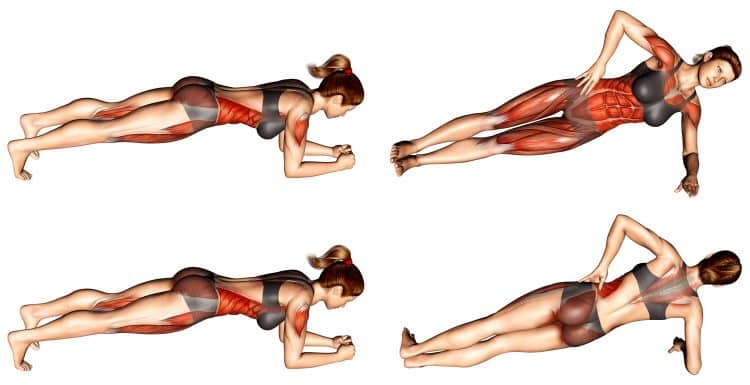
- Core/abs – Consisting of your abdominal, oblique and erector muscles, the core is an integral part of performance, aesthetics and bodily health. The abdominals aren’t just for show but they stabilize our spine and help us to bend. Obliques allow us to rotate in opposite directions and flex to the sides while the back extensor are necessary for various movement. You really want to focus on this section of muscles during rolling bridges.
- Adductor Brevis – Adductor muscles like the brevis assist in pulling our thighs inward toward the center of the body. But it also helps with trunk stability, maintaining balance, and flexion of the thigh.
- Adductor Longus – Pulls the thigh medially inward like other adductors. Longus is one of the strongest muscles of the thigh.
- Deltoid Anterior – The anterior head, unlike lateral and posterior raise the arm up and forward into a flexed position (1).
- Gluteus Maximus – The biggest butt muscle and muscle in the human anatomy, gluteus maximus is a very important muscle that extends and externally rotates the thighs. When you push through your heels into the ground the butt muscles get a lot of activation.
- Iliopsoas – Iliopsoas is the boss of hip flexor muscles, consisting of major, minor and iliacus that can function separately or as a unit during functions like movement and stability (2).
- Pectineous – The pectineous is a uniquely named muscle in the upper thigh that belongs to the adductor family. It’s the most anterior adductor and primarily a hip flexor although it does help to medially rotate the thigh.
- Pectoralis Major – Consisting of an upper and lower set of muscle fibers, the pectoralis or chest muscles Adduct and medially pull the arms inward toward each other.
Bottom Line
All you need is a good back and soft surface to get the rolling bridge into motion. This multi-movement exercise combines resistance, stretching and massaging all in one for the ultimate morning routine or anytime activity that helps to keep your lower body, spine, and neck muscles flexible and mobile.
Remember, if you typically have back issues then skip this one but for those who are able, rolling bridges may make a nice addition to your current healthy body routine!
References:
1. Elzanie, A., & Varacallo, M. (2022, May 15). Anatomy, Shoulder and Upper Limb, Deltoid Muscle – StatPearls – NCBI Bookshelf. Anatomy, Shoulder and Upper Limb, Deltoid Muscle – StatPearls – NCBI Bookshelf.
2. Bordoni, B., & Varacallo, M. (2022, April 29). Anatomy, Bony Pelvis and Lower Limb, Iliopsoas Muscle – StatPearls – NCBI Bookshelf. Anatomy, Bony Pelvis and Lower Limb, Iliopsoas Muscle – StatPearls – NCBI Bookshelf.
Interested in measuring your progress? Check out our strength standards for Hip Thrust, Glute Bridge.


